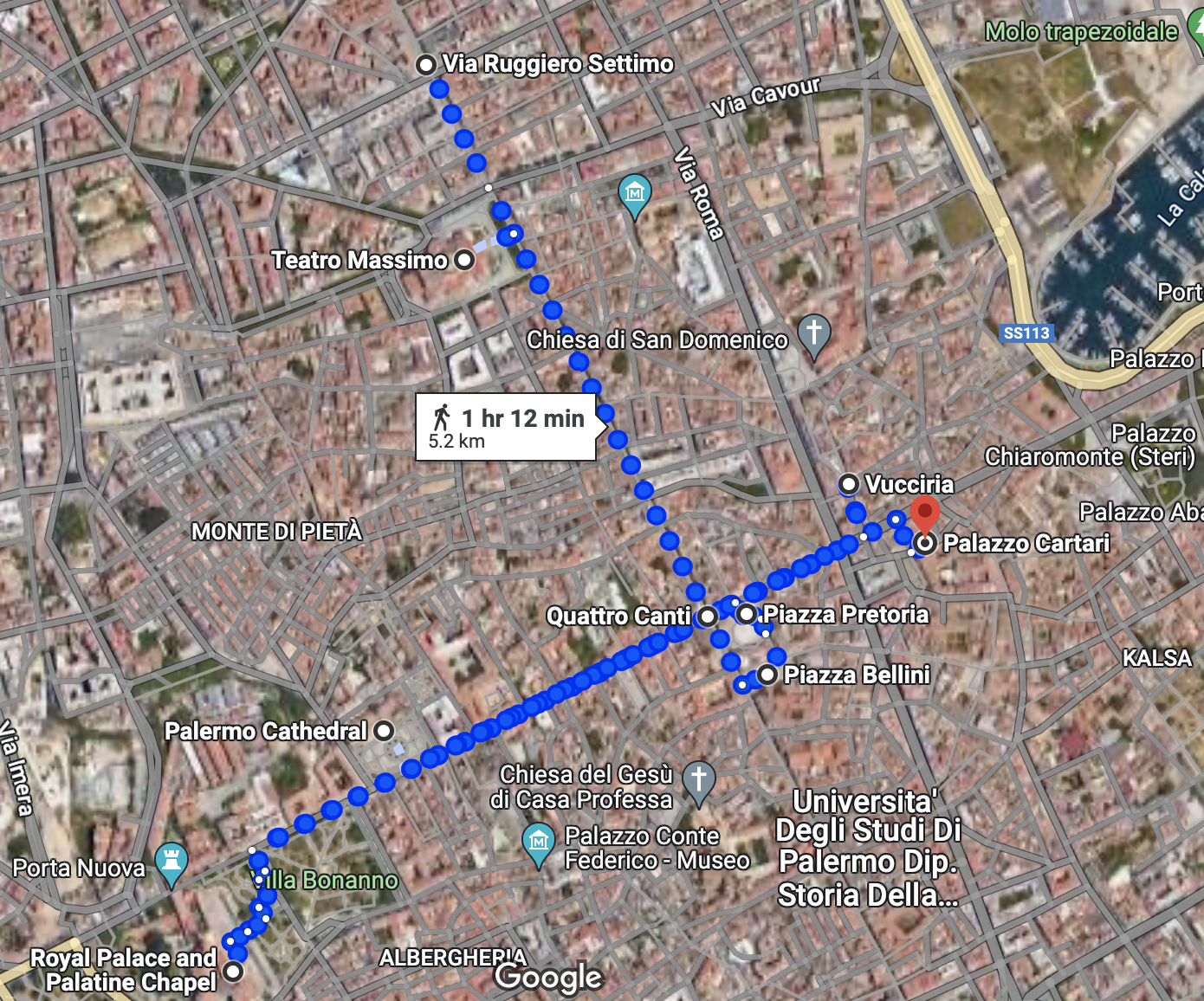PALAZZO CARTARI
via dei cartari 21

Palazzo Ferreri Ventimiglia di Prades, later Palazzo Larderia, located at 188 Corso Vittorio Emanuele, with another entrance at 19 Via dei Cartari, was the headquarters of the Department of History and Design in Architecture and the Department of City and Territory until December 31, 2010.
In 1567, the Senate of Palermo deliberated the start of a major urban operation, and it was during those years, at the behest of the Genoese merchant Paolo Ferreri, that the construction of a large residence began.
In 1750, the renowned architect Giovan Battista Vaccarini, commissioned by the new owner Antonio Ventimiglia, Count of Prades, developed a new restoration project for the construction, which was not yet completed. The last restoration campaign dates back to 1976 and 1982, on behalf of the I.N.A.

“The Via dei Cartari was primarily occupied by manufacturers of playing cards, and the Mercedarian fathers chose this area because they needed a convent within the old city walls. The passion for playing cards is very ancient, and Palermo has been a witness to it since the fifteenth century when the cards were called ‘naibi‘ (from the Spanish ‘naipe,’ which means playing card) and were a game intended for children.

The square is located in the ancient district of Lattarini where once stood the Church of the Immaculate Conception and the convent of the Barefoot Reformed Mercedarians, better known as the Church of the ‘Immaculate Conception’ at the Cartari.
For the construction of this convent, the palace of the Baron of Gratteri was purchased. However, due to issues with the baron’s heirs and, more importantly, the opposition from the religious communities of the nearby convents of San Francesco d’Assisi and Santa Maria della Misericordia, the project was temporarily shelved.
“Only on September 9, 1634, with the consent of Cardinal Giannettino Doria, Archbishop of Palermo, and the President of the Kingdom Luigi Guglielmo Moncada, Duke of Montalto and Prince of Paternò, who personally contributed to the realization with 800 ounces, the work was finally completed.”
As a result of the Law of July 7, 1866, which decreed the suppression of monastic corporations, even the convent of the Barefoot Mercedarians, located in the district of Lattarini, was acquired by the state domain.
On February 10, 1887, the former convent was purchased by the Chamber of Commerce in partnership with the Central Savings Bank Vittorio Emanuele II.
This new square was first called ‘della Borsa’ because, in the nearby Vicolo della Madonna del Cassaro, the so-called ‘small Borsa‘ was held, where merchants, brokers, and ship owners gathered to buy or sell goods landed at the Cala or to charter ships. As you can see, what happened had nothing to do with ‘high finance.’ They did not buy or sell stocks or bonds but potatoes, wheat, wine, or Eastern spices, which were then more valuable than gold.
In 1891, after the first necessary adjustments, the Savings Bank opened its new branches there, and in 1907, it entrusted architect Ernesto Basile with the project for its expansion towards Piazza Borsa, in the area originally occupied by the church.
Here’s a walking itinerary starting from Palazzo Cartari and covering some of the most iconic places in the center of Palermo:
(click the image to discover the itinerary)
1. Via dei Cartari: Start your journey from the hotel, immersing yourself in the vibrant atmosphere of this historic street.
2. Quattro Canti: Continue along Via Maqueda until you reach Quattro Canti, a baroque square that marks the central point of the historic center.
3. Piazza Pretoria: Head south until you reach Piazza Pretoria, where you can admire the monumental fountain, also known as the Fountain of Shame.
4. Piazza Bellini: Continue your journey south-east to Piazza Bellini, where you can visit the Church of Santa Maria dell’Ammiraglio, better known as Martorana, and the nearby Church of San Cataldo.
5. Palermo Cathedral: Head northeast along Via Vittorio Emanuele until you reach Palermo Cathedral, a masterpiece of Norman architecture.
6. Mercato della Vucciria: From there, head west along Via Roma until you reach the Mercato della Vucciria, a lively open-air market where you can savor the flavors and aromas of Sicilian cuisine.
7. Norman Palace and Palatine Chapel: Take a detour north to visit the Norman Palace and Palatine Chapel, two important historic sites in Palermo.
8. Teatro Massimo: Continue along Via Maqueda until you reach the Teatro Massimo, the largest opera house in Italy and one of the city’s best-known symbols.
9. Via Ruggero Settimo: Finish your itinerary by heading along Via Ruggero Settimo, one of the main shopping streets of Palermo, where you can find luxury boutiques and fashion shops.
This itinerary will give you a taste of the beauty and culture that Palermo has to offer, starting right from the hotel. For any information or to book a private tour guide, contact the reception.
